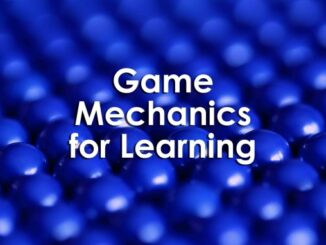
One of the much-vaunted advantages of using games to facilitate learning is the idea of the ‘safe environment’. The premise is, that players and teams can experiment with taking actions, and, because there are no real-world consequences of these actions, they are freed to be less cautious. In a business learning game, for example, normally risk-averse employees can play at being much bolder. They can be more lavish than usual with spending. They can be daring when deciding which new product lines to pursue. It may even be one of the learning outcomes, to encourage players to be more innovative and forthright when they return to business as usual.
This idea can be extended in a number of ways. One method would be the ‘rewind’, which is popular in the kind of learning games where there is a ‘right answer’ or at least a limited number of preferred routes through the game. For example, let’s say we have created a game which is designed to reduce siloing within a business. The learning designers have identified communication issues as a problem within the business, and the game aims to illustrate this. Players comes to understand this idea – through one or more rounds of the game which have had disastrous results.
Rewinding the game
Each time the game is ‘rewound’ to a starting position, usually along with some teaching in between each round, to introduce a better tool or technique, or behaviour. The results of each round thus get progressively better, until by the end of the training, each team achieves some measure of success, and the learning about the improved approach is hopefully embedded.
Even games which are not ‘rewound’ within each play, will be ‘rewound’ between one instance of play and the next. A team may play several rounds of the same game, with each round building on the results from the last. But the next time the game is played anew, with new teams, it will start from the same position it always has.
You may think that this is self-evident. This is the way games, serious or otherwise, have always worked. Each time you get ‘Monopoly’ out of the box, everyone will start from the same position and you have a new opportunity to win, even if you lost last time.
Legacy games
But then came ‘Legacy’ games, and these games, I would argue, are particularly appropriate for learning about environmental sustainability.
The basic idea of a legacy game is that the game itself evolves over time, as a result of the decisions made by players within play. There is no possibility of ‘rewind’. The game world is irrevocably changed by each and every play that is made. In tabletop games, this manifests, for example through the use of stickers which are added to the board, permanently changing it, or through the permanent destruction of game pieces, or by the opening of previously sealed game elements.
Rather appropriately for the times we are now living through, one of the first legacy board games was ‘Pandemic Legacy’ in 2015. This was created by Matt Leacock (original creator of Pandemic) and Rob Daviau (the originator of the Legacy mechanic). Like a lot of legacy games, this is designed to be played as a ‘campaign’, over multiple play sessions and with an unfolding storyline. Because the rules and game elements are changed by the legacy mechanic through play, the experience of playing the game will be near to unique for each group of people who play it.
Planetary Boundaries and Tipping Points
When I first learned about legacy games, I was working delivering learning in Environmental Sustainabilty to corporate employees. It immediately struck me that this was exactly what we needed to do with learning games in this field. The mechanic is particularly appropriate for learning about the concepts of Planetary Boundaries and Tipping Points.

According to the Stockholm Resilience Centre, there are nine planetary boundaries, including Climate Change and Biosphere Integrity. The current state of each of these aspects of the planetary system can be represented diagrammatically, so that we can see whether we are currently operating within safe limits or not.
The green part of the diagram represents the zone of operation within which sustainable growth can occur. So long as human actions do not move the planetary system beyond the green zone, then we are ‘safe’. Once the metric for any boundary moves beyond the green zone, we are operating in increased risk. As the metric moves into the areas of increased and critical risk, boundaries representing stable regimes are breached. That aspect of the planetary system then moves into a new stable regime. This is the concept of ‘Tipping Points’. Once we have passed a tipping point there is no returning. A good way to visualise this is as a ball bearing moving on an undulating track (but with a general ‘downhill’ trend). Once the bearing reaches a peak, it will ‘tip’ into the next valley. It would then need to go uphill to return to the previous valley, which it cannot do.

Legacy games provide an excellent way of doing several things in this context:
- Demonstrating the ‘one-way’ trend of planetary boundaries and tipping points
- Creating long-term learning experiences which can be returned to over time (campaign games), and which represent irrevocable changes over that period of time
- Allowing changes ‘outside of play’ to be made by designers in response to changes discovered by e.g. scientific research, real-world events
- The legacy mechanic itself is a powerful analogy demonstrating that our actions and decisions have far-reaching and irreversible consequences
- Demonstrating the importance of each decision. Although this is still a game, and therefore ‘safe’ in that your decision is not actually impacting the ‘real world’ , in a campaign you will have to ‘live with’ that decision and its consequences in the long term.
In commercial ‘for fun’ games, Legacy is an endlessly fascinating mechanic. In the hands of a skilled learning designer it can be a tool which can drive a whole new generation of games for deep and lasting learning in some of our most complex and biggest challenges.
- James Bore – The Ransomeware Game - 13th February 2024
- Ipsodeckso – Risky Business - 23rd January 2024
- Review – Luma World Games - 15th December 2023





Rewinding and legacy mechanics are two exceptionally powerful tools for the game designer. Thanks for these insightful examples.
Thanks, Michael. I love Legacy games. One of my favourite (and most expensive, and most definitely heaviest) purchases is Gloomhaven. It answers the intractable question, “What do I do if I want to play Dungeons & Dragons, but I’m a grown-up who doesn’t have nay friends who have time to be a DM?” It is also such a well-designed legacy game, that it is a real masterclass in how to create a great legacy experience.